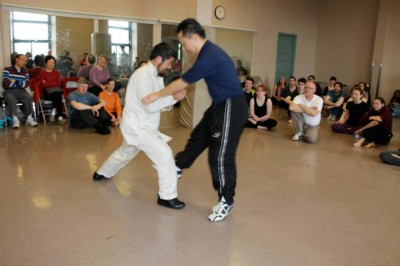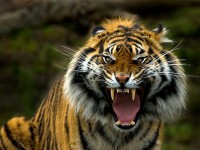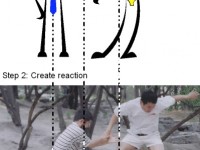 Rachel, Daniel and James did an excellent job organizing an Open House and Workshop for the Weekend of April 05-06, 2014. On a fine spring morning, more then 50 people showed up for an introduction to Chen Style Practical Method and to meet one of the system’s outstanding proponents, Master Joseph Chen Zhonghua. This Open House was helped by Daniel’s group at the University of Ottawa and supported by the Ottawa Tai Chi Chuan Association (OTCA).
Rachel, Daniel and James did an excellent job organizing an Open House and Workshop for the Weekend of April 05-06, 2014. On a fine spring morning, more then 50 people showed up for an introduction to Chen Style Practical Method and to meet one of the system’s outstanding proponents, Master Joseph Chen Zhonghua. This Open House was helped by Daniel’s group at the University of Ottawa and supported by the Ottawa Tai Chi Chuan Association (OTCA).
For more then two and half hours, the audience was treated to a history and philosophy of Taijiquan that eventually lead to the establishment of the Practical Method by Master Hong Jungshen. Master Chen started the demonstration by performing the first section of the Yilu. Daniel’s students then performed a group form. Finally, students John (Ottawa) and Ken (Toronto) performed the complete Yilu. A series of workshop followed after the open house. The following are my observation during the weekend.
A video summary for this open house is now available (for members only)
Questions and Answers
Near the end of the open house, Master Chen asked the audience if they have any questions. You can see the video of the Q&A session here. Two questions stand out in my mind and those questions are often asked by many beginners around the world.
Q1. What is the “best” style (Yang, Chen, Wu, Wu (Hao), Sun) to practice?
Master Chen was polite and never directly answered the question by promoting The Practical Method. Saying that Taijiquan is based on one underlying principle. Different styles represent the signatures of the particular teacher. My understanding of this question is related to the interest in the difference in Yilu practice by different branches of the Chen style. I am satisfied with the answer reached by Master Hong. According to Hong, his teacher, Chen Fake himself changed Yilu over his life time. The guiding principle for any change is according to Chen Fake’s words: “This set of Taijiquan does not have one technique which is useless. Everything was carefully designed for a purpose.” (“这套拳没有一个 动作是空的, 都是有用的”) . This principle, according to Hong, can be derived from “The Taijiquan Treatise” (太极拳论) by Wang Zongyue (王宗岳). This idea is expressed by the phrase “Although there are myriad variations, there is only one underlying principles.” (“虽变化万端, 而理为一贯”).
Q2. “How to find the best teacher?”
Master Chen started that in the end it is a matter of fate. Master Chen relates how he was lucky that he happened to come across Master Hong and later was introduced to Master Feng. It is also fate that a teacher meets the right student. This is the customary traditional Chinese and Taoist approach.
My personal opinion is a bit more pragmatic, you can open your mind so that you can recognize the opportunity when presented. Based on my experience, I look less in to the fame and ability of the teacher but in the quality of his students. If the instructions cannot raise the standards of his students, how can I personally benefit from the training? Regardless of Master Chen Fake’s personal achievements, his lasting legacy was through his students such as Master Feng and Master Hong. Similarly, Master Hong have students such as Master Chen and Master Li who are regarded as the new representatives of the Chen Taijiquan tradition. I have now met and seen some of Master Chen’s disciples such as Ronnie Yee, Steve Chan and Chen Xu. I feel they are acquiring the skills of their teacher.
Push hands and the eye of the Tiger
The Ottawa group was very excited after the success of the Open House. A few members of the audience stayed for the workshop. In Ottawa, each workshop has participants that ranged from novices to seasoned practitioners of the Practical Method. I have participated in a few workshops and now can see the progress of different participants over time. It was a great pleasure to try out techniques with students from Toronto, Montreal and Philadelphia and see their improvement since the last workshop.
Push hands are an important component of the Practical Method training because it is a direct test for your understanding of the principles. In general, beginners like me will go back to relying on pure strength rather then on the Taijiquan training to elicit a response from the opponent. Master Chen will personally show you how a technique should really be performed in accordance with Taiji principles.
 An interesting observation I had during this period of push hand training. In a previous post, I have commented on Master Chen’s push hand’s skills. I was a little bit more comfortable and energetic so I liked to experience Master Chen’s longer range skills. I happened to touch Master Chen from the side as he walked by. His instant reaction was to turn and execute a direct straight line strike to the bridge of my nose and a stomp to my knee that stopped within fraction of the target. From a martial arts perspective, the technique was a thing of beauty. From a personal perspective, my action was as dangerous as the time when I petted a tiger (a story for another time). Not recommended for the faint of heart.
An interesting observation I had during this period of push hand training. In a previous post, I have commented on Master Chen’s push hand’s skills. I was a little bit more comfortable and energetic so I liked to experience Master Chen’s longer range skills. I happened to touch Master Chen from the side as he walked by. His instant reaction was to turn and execute a direct straight line strike to the bridge of my nose and a stomp to my knee that stopped within fraction of the target. From a martial arts perspective, the technique was a thing of beauty. From a personal perspective, my action was as dangerous as the time when I petted a tiger (a story for another time). Not recommended for the faint of heart.
Another personal note at the end of the day, I was so tired and every muscle in my body ached. This just shows you my lack of understanding of the Practical Method.
Indirect Power – Positive and Negative
The use of indirect power is the root of Taijiquan applications. According to Master Chen, Indirect Power can also be known as Indirect Action or “Structural Power”. According to this principle, reaction from the opponent is not due to action at the point of contact but else where. Direct power exists at the first point of contact. In Taijiquan, this point of contact represents an anchor, hook or handle where other actions can occur. A clear analogy of this concept can be seen in fishing. The fish hook catches the fish but it is the line and reel that drags the fish in. Indirect power comes in two forms, Positive and Negative.
Positive Indirect Power
In terms of Positive Indirect Power in Taijiquan, there are nine levels of holds (due to the joints existing on the human body). You can classify the levels of indirect power based on the number holds that your action has involved. For example, direct power involves only one hold (the point of contact). A first class indirect power involves two holds. A second class indirect power involves three holds. Finally, an eighth class indirect power involves all the holds (joints).
Figure 1 is an illustration of this concept. In Figure 1, the opponent is fixed in position A. He grabs an arm at point B. The points A and B creates the first hold. In normal action, the fight is on this line A-B and it is considered to be an application of direct power. Through Chen Taiji training, you will maintain the distance A-B and add the actions of the kua (Point C), this represents Level 1 indirect power. If you add the actions of the knee (Point D), you will achieve Level 2 indirect power (using three holds). By adding the actions at each joint, your opponent will feel that that is a force on A-B but this force is not due to the direct power at A-B but the indirect (structural power) created by the Chen Stylists. Conceptually, each level (addition) can be understood as an increase in distance due to the involvement of each joint. For example, for Level 1 indirect power, the increase in distance is from BC. Similarly, for Level 2 indirect power, the increase in distance is BD. The difficulty in the use of indirect power is over emphasis on direct power (moving the point of contact) and leakage (other body parts moving).
Negative Indirect Power
Negative Indirect Power requires two actions. The first action reduces the distance and the second action creates a reaction.
Figure 2 is an illustration of negative indirect power. In Step 1, X and Z denote two points created by the Chen Stylist (X) and his opponent (Z). The distance between point X and Z is X-Z. The Chen stylist then takes the space in Y (for example, by moving a leg). The Chen stylist has reduced the distance by X-Z by the distance X-Y. In Step 2, the Chen stylist can create a reaction from his opponent based on this reduced distance. For example, the Chen stylist can extend his hand. Again, the reaction is due to structural power (through the reduced distance) rather then direct (muscle) power. The problem with using negative indirect power is that the point of contact must not move. The opponent should always feel that he is still in control.
Indirect Power according to Master Hong
Master Chen once told us this story about indirect power and now I finally understand its meaning. Master Hong was training at his usual spot. Close by, some young muscular young men were playing basketball. During a break, one of those young man came over and asked Master Hong what he was doing and how useful was his “quan”. Master Hong points to a big rock and tells the young man to move it over to Master Hong’s position and then he will answer his question. The young man dutifully picked up the rock and moved it over to the feet of Master Hong. Master Hong then replied “This is my quan – moving the rock from there to here”. I did not get it when I first heard the story but now I see how it illustrates perfectly the concept of indirect power!
Difficulty in Learning the Practical Method
Master Hong reminded us, in order to learn his quan:
還需要, You also need
有良朋, To have good friends
同學拳, To practice
可互助。 And experiment
Workshops are perfect opportunities to meet new friends and test your understanding of the Practical Method.





{ 8 comments… read them below or add one }
Ming, great review article! You summarized it really well with all the critical details that I have missed or that have already grown fuzzy on me. You are indeed Great Article Ming! We are all also privileged to have a great training partner and leader in you. Thanks!
For those who are not aware, there is an update on the wiki entries of Master Chen Zhonghua (http://en.wikipedia.org/wiki/Chen_Zhonghua), on Grandmaster Hong Junsheng (http://en.wikipedia.org/wiki/Hong_Junsheng) and Grandmaster Chen Fake(http://en.wikipedia.org/wiki/Chen_Fake). When you have a chance, please check it out.
As James says, another excellent piece from Great Article Ming (TM)!!
Thanks Ming, your notes will be very useful to me.
Excellent article again Ming! Thanks for taking the time to write it up and submit it. I agree with my esteemed fellow students – you article does sum-up well the key points of the weekend and provides the detail needed to further learning.
I also want to thank you for being a good practice partner.
Does anyone learn with your meathod? It is well thought out and beautifully explained.Yet it seems that it needs to be felt.
Does anyone know of a study group in the Ottawa area practicing this style? I am new to the Ottawa area and would love to participate.
You can contact James Tam or Rachelle Bergeron from Ottawa – Chen Style Taijiquan Practical Method
https://www.facebook.com/groups/463162150390351/
Asim,
The Ottawa group practice is on the weekend, Saturdays 1:00-300 p.m. We will be moving to a new location soon at Tom Brown Arena, 141 Bayview Rd and it won’t commence till October 25. As well, there is going to be a new class organized by the Ottawa Tai Chi Chuan Association (OTCA), beginning Sept. 28, where I will teach the Practical Method Yilu (hand form) 9:30-11:30 a.m. Finally, there will be an OTCA Open House on Sept 7 (9-11:30am, Adult High School, 300 Rochester) where there will demos of the several styles of tai chi that will be taught by different instructors at the same school location.
James Tam
Asim, we have a practice group in Ottawa, ON that meets Saturdays 1-3 p.m. at Tom Brown Arena at Bayview (beginning in October). There will be a NEW class beginning in September at the Adult High School, 300 Rochester St., 9:30-11:30 a.m. on Saturdays. Please check the Ottawa Taichi Chuan Association’s (OTCA) calendar at http://www.ottawa-taichi.ca/calendar for REGISTRATION and OPEN HOUSE dates. Please contact me (jtam007@hotmail.ca) for more details about (1) the new Practical Method class and (2) the ongoing practice in Ottawa. Rachelle at rachelle.bergeron@rogers.com can also provide you with details of the practice group as well as the Master Chen Zhonghua workshops that she hosts.
James